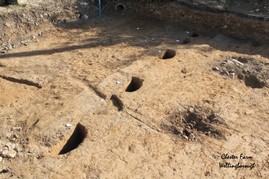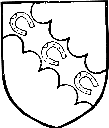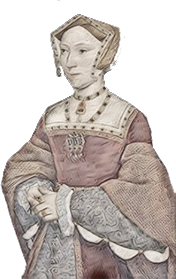Morinsbury Manor
Mowsbury Hillfort
In search of Ralph Morin
Manorialism came about during the Roman era. It occurred when the landowners needed to control both the land they owned and the people who worked it. This was a necessity in the midst of the civil disorders, weak government and barbaric invasions that engulfed Europe in the 5th and 6th centuries. During this time the small farmers and peasants who worked the land exchanged their freedom and guaranteed their services in return for the protection of the landowners who were able to defend them.
This medieval site has been identified with the Manor of Morinsbury, mentioned in various documents prior to 1465. The name may have been retained as `Morsebury'- the title of a field owned by the Goswick family in the 16th century which included the area of earthworks and presumably devolved to the present name of Mowsbury.

Rural manor houses in the early medieval period would have been relatively small. Their size would have been restricted probably to about two metres in width depending on the lengths and cost of the cross support timbers. (Photograph of medieval post holes at Chester Farm, Wellingborough). The main vertical timbers would have been dug into the ground occasionally placed on stone supports. The external structure would have been plastered with wattle and daub and and the roof thatched.
The majority of moated sites served as prestigious aristocratic or seigneurial residences, with the moat acting as a status symbol rather than a means of military defence. Moated sites reached a peak of popularity between the mid 13th and 14th centuries.
Reference to a Ralph de Morin is found in Bedford in 1180. He married heiress Albreda de Braose in 1194, and with his marriage acquired lands including property in Harrold held from the heirs of Countess Judith as part of the Honour of Huntingdon. In 1194 Simon de Blosseville, another tenant of the Honour of Huntingdon who then held Harrold Manor, recognised and acknowledged the right of Ralph Morin to four hides of land in the Parish, and this appears to have been the beginning of this family’s rise up the social and land owning classes. Soon after, Ralph paid to the Sheriff of Bedfordshire, sixty two shillings and a penny, the first part of his knight’s fee calculated according to the size of his land holdings. Among the lands that Morin acquired in 1207 was a part of the Parish of Ravensden, including the former hill fort now known as Mowsbury Hill. On this ancient site he constructed a large wooden moated Manor House and this soon became known as Morinsbury or Mowsbury Castle.

The first Ralph Morin probably died between 1208 and 1213; he was succeeded by his son, another Ralph. This second Ralph Morin fought against King John in 1216, and was one of the knights forced to surrender in Belvoir Castle (Leicestershire) when John threatened to starve the castle’s owner to death. Ralph forfeited his lands, but they were returned to him in 1217. Besides his Bedfordshire lands he held land in Buckinghamshire, Surrey, Somerset, Devon, Kent and Northamptonshire. In 1232 he reached an agreement with Simon de Blosseville over the four hides of land in Harrold which appears to have ended the Blosseville’s association with that manor. In 1235 Ralph Morin was recorded as holding two knight’s fees in Harrold from the Honour of Huntingdon. He probably died in 1254.
Ralph was succeeded by his son John, who was dead by 1263, leaving his son, another Ralph, as his heir. Ralph was a minor and he was put into the wardship of his overlord at Harrold, Sir Henry Hastings. When Hastings was wounded and captured at the battle of Evesham, his lands were forfeited, but restored in 1267. Ralph Morin married Isabel, sister and co-heir of John, son of Oliver de Lovetot. In 1275 he was imprisoned in Oxford Gaol on suspicion of having lost a gerfalcon of the King, but he was released when it was found.
The name Mowsbury is a corrupted name for Morinsbury, Morin and "Bury" being an old English word for castle or fortification. The name may have been retained as "Morsebury" a 16th century field name, which included the area of earthworks.
The second Ralph Morin (who fought against King John in 1216) had a daughter who married John de Pabenham. Their descendants included three wives of Henry VIII - Anne Boleyn, Jane Seymour and Catherine Howard - and Elizabeth I and Edward VI. Thus within 10 generations, the family of de Morin moved from country squires to monarchs of the realm

The Elder

The Younger
Information sources:
bedsarchives.bedford.gov.uk/CommunityArchives/Ravensden/Morin-Family.aspx
www.british-history.ac.uk/vch/beds/vol3/pp63-68
harroldpriory.blogspot.co.uk/2014/08/nuns-priests-and-prioresses.html
www.british-history.ac.uk/
www.british-history.ac.uk/vch/beds/vol1/pp371-377
www.finerollshenry3.org.uk/content/calendar/roll_009.html
harroldvillage.co.uk/harrold-history-the-de-morin-family/
Elizabeth Cheney

The above information was derived from many different sources and as the actual history at this time appears somewhat vague we would welcome any assistance in correcting this brief history of the Morin’s connection with Mowsbury Hillfort.
Acknowledgements and credits
Ralf Morin and Morinsbury Manor are still being researched. Any assistance with further information or to put us right on the heritage of this family would be gratefully appreciated. contact@putnoemowsburyfriends.org.uk

